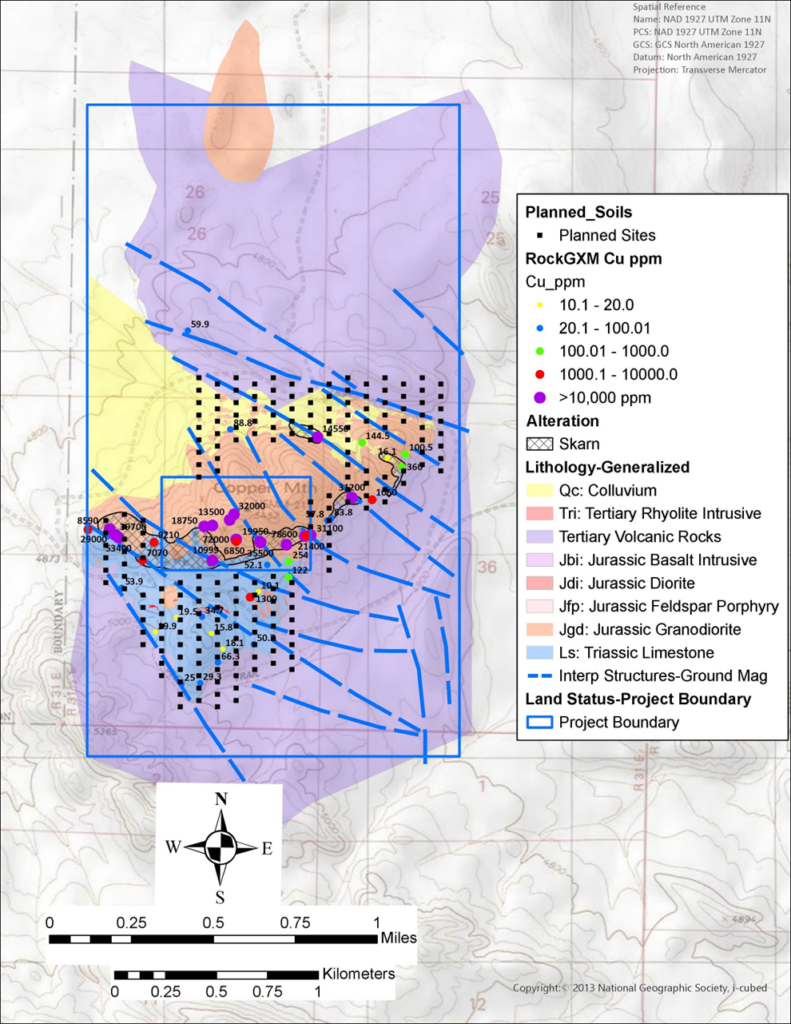Vancouver, British Columbia, April 2, 2024 – Manning Ventures Inc. (the “Company” or “Manning”) (CSE: MANN; Frankfurt: 1H5) is pleased to announce that Phase One exploration is underway at the Copper Hill Project, located within the Walker Lane Trend, Nevada, USA.
Geological personnel are on site and conducting phase one work of the staged exploration program at the Copper Hill Project, within the Walker Land Trend, Nevada, USA. The first phase of target generating work consists of detailed geologic mapping, soil geochemistry, and a property-wide gravity survey. These programs will be integrated to develop a comprehensive picture of the project. The results will be combined with all available historic data to outline target areas that can be tested with core and reverse circulation drilling.
Geologic mapping will add details to the property-wide geologic map completed in the early 2000’s. Copper Hill is centered on a Jurassic Age quartz monzonite porphyry that intrudes the surrounding Triassic Age Luning Limestone, which was then cut by a variety of intrusive dikes. Zones of porphyry-related copper and gold-bearing skarn mineralization occur at the intrusive-limestone contacts and along fault zones in the intrusive.
Detailed mapping will focus on defining:
- The extent and location of the skarn mineralization.
- Delineating skarn mineralization zoning details, around the historic mining and other areas of the project with anomalous copper and gold in the rock geochemistry.
- Delineating porphyry-copper alteration zoning that may provide a vector to a hidden porphyry copper type target.
A soil geochemistry program to collect approximately 220 soils is laid out to sample rock contact/skarn zones, fault zones interpreted from a ground magnetic survey, and areas covered by shallow colluvial gravel. Sites are spaced every 61 meters (200 feet) on north-south lines spaced 91 meters (300 feet) apart. Samples are laid out to outline and extend the areas of high-grade and anomalous copper, gold, and molybdenum mineralization sampled in the historic rock chip samples. The samples will be analyzed using a 4-acid digestion method which will provide analyses for economic minerals plus trace elements that are known to be associated with porphyry-related skarn mineralization (silver, zinc, bismuth, and tin).
The gravity geophysical program will aid in determining the extent of the intrusive and limestone rocks. Sample locations are laid out to provide enough points to show the density contrasts between the different lithologies. This will provide data to help delineate the various rock types and define fault zone orientations at depth, below the surface.

Image 1: Copper Hill Project Geology with Cu in Rocks
The Company will update the program as it progresses in the weeks ahead.
About the Copper Hill Project
Copper Hill hosts copper-gold-molybdenum mineralization in both porphyry and skarn styled deposits in Mineral County, Nevada. The property consists of 66 mineral claims covering an area of 2.3 miles. The property is located 22 miles north of Hawthorne, Nevada and is accessible using well-maintained County Roads.
The Project is centered on a Jurassic Age quartz monzonite porphyry intruding Triassic age Luning Limestone. The claims cover 2.3 sq miles and are 33 miles east of the Yerington Copper District which hosts the Yerington Copper Mine (Anaconda 1952-1978), Ann Mason Deposit, Bear Deposit, MacArthur Deposit, and the Pumpkin Hollow Mine.
Historically at Copper Hill, reported high-grade copper was mined from underground shafts from skarn and porphyry-copper styled mineralization at the Copper Mountain Mine. Between 1914 to 1926 mining from the “Copper Mountain Mine” produced an estimated 1,000,000 pounds of copper from shallow underground workings. Historic reporting from the period of production describes ore zones of contact skarn- type and porphyry-type mineralization with shipping grades ranging from 3.5 to 11.0% copper*.
*Historic Minning information was summarized from an “Unpublished Report on the Carson Sink Area, Nevada by F.C. Schrader, U.S. Geological Survey (Field work 1911-1920) 1947”. Manning Ventures cautions investors that the historic exploration and production information is believed to be accurate but has not been verified by a qualified person.
The Copper Hill mineralizing system forms a topographic high surrounded and partially covered by younger volcanic rocks. Mineralization identified at Copper Hill are bornite, chalcocite, chalcopyrite, chrysocolla, copper-native, covellite, cuprite, gold, malachite, molybdenite, silver, sphalerite (rare), and tetrahedrite.
The Copper Mountain area was explored between 1959 to 1979 by Idaho Minning Corp. and Walker-Martel who conducted ground geophysics, underground mapping, prospecting and reported 6000 feet of Rotary drilling. Since that time ground magnetics were conducted in 2007.
Rock sampling collected at this time returned values from select samples of 7.2% and 12.7% copper and 1.06 g/t gold and 1.19 g/t gold respectively.
The target being sought at Copper Hill is a porphyry styled copper-molybdenum-gold deposit.
Warren Robb P.Geo., is the designated Qualified Person as defined by National Instrument 43-101 and is responsible for the technical information contained in this release.
About Manning
Manning Ventures is a mineral exploration and development company focused metals and materials critical to the growing Energy Metals space. Manning’s project portfolio is focused on Copper in Nevada, Lithium/Copper in Ontario and Quebec, and multiple Iron Ore projects in Quebec.
For further information contact:
Manning Ventures Inc.
Alex Klenman – CEO
Email: info@manning-ventures.com
Telephone: (604) 681-0084
www.manning-ventures.com
FORWARD LOOKING STATEMENTS:
The Canadian Securities Exchange does not accept responsibility for the adequacy or accuracy of this news release.
Certain statements in this press release may contain forward-looking information (within the meaning of Canadian securities legislation), including, without limitation, the Company’s payment of the Exercise Price during the Option Term, the granting of the net smelter return royalty to the Optionor, and the Company’s payment of the annual minimum payments to the Optionor. These statements address future events and conditions and, as such, involve known and unknown risks, uncertainties, and other factors, which may cause the actual results, performance, or achievements to be materially different from any future results, performance, or achievements expressed or implied by the statements. Forward-looking statements speak only as of the date those statements are made. Although the Company believes the expectations expressed in such forward-looking statements are based on reasonable assumptions, such statements are not guarantees of future performance and actual results may differ materially from those in the forward-looking statements. Factors that could cause the actual results to differ materially from those in forward-looking statements include regulatory actions, market prices, and continued availability of capital and financing, and general economic, market or business conditions. Investors are cautioned that any such statements are not guarantees of future performance and actual results or developments may differ materially from those projected in the forward-looking statements. Forward-looking statements are based on the beliefs, estimates and opinions of the Company’s management on the date the statements are made. Except as required by applicable law, the Company assumes no obligation to update or to publicly announce the results of any change to any forward-looking statement contained or incorporated by reference herein to reflect actual results, future events or developments, changes in assumptions, or changes in other factors affecting the forward-looking statements. If the Company updates any forward-looking statement(s), no inference should be drawn that it will make additional updates with respect to those or other forward-looking statements.
